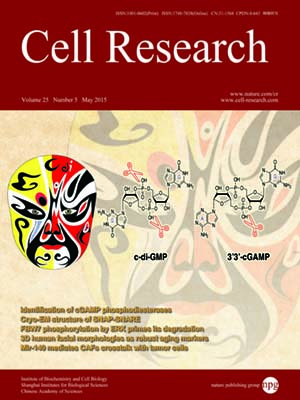
Volume 25, No 5, May 2015
ISSN: 1001-0602
EISSN: 1748-7838 2018
impact factor 17.848*
(Clarivate Analytics, 2019)
Volume 25 Issue 5, May 2015: 539-550 | Open Access
ORIGINAL ARTICLES
Identification and characterization of phosphodiesterases that specifically degrade 3′3′-cyclic GMP-AMP
Juyi Gao1,2,4,*, Jianli Tao1,2,4,*, Weili Liang5,6,*, Meng Zhao5, Xiaoxia Du1, Shan Cui3, Haifeng Duan3, Biao Kan5,6, Xiaodong Su1,3 and Zhengfan Jiang1,2,4
1State Key Laboratory of Protein and Plant Gene Research, School of Life Sciences, Peking University, Beijing 100871, China
2Key Laboratory of Cell Proliferation and Differentiation of the Ministry of Education, School of Life Sciences, Peking University, Beijing 100871, China
3Biodynamic Optical Imaging Center (BIOPIC), School of Life Sciences, Peking University, Beijing 100871, China
4Peking-Tsinghua Center for Life Sciences, Beijing, China
5State Key Laboratory for Infectious Disease Prevention and Control, National Institute for Communicable Disease Control and Prevention, Chinese Centre for Disease Control and Prevention, Beijing 102206, China
6Collaborative Innovation Centre for Diagnosis and Treatment of Infectious Diseases, Hangzhou 310003, China
Correspondence: Xiaodong Su; Zhengfan Jiang(xdsu@pku.edu.cn; jiangzf@pku.edu.cn)
Cyclic dinucleotides act as intracellular second messengers, modulating a variety of cellular activities including innate immune activation. Although phosphodiesterases (PDEs) hydrolyzing c-di-GMP and c-di-AMP have been identified, no PDEs for cGAMPs have been reported. Here we identified the first three cGAMP-specific PDEs in V. cholerae (herein designated as V-cGAP1/2/3). V-cGAPs are HD-GYP domain-containing proteins and specifically break 3′3′-cGAMP, but not other forms of cGAMP. 3′3′-cGAMP is first linearized by all three V-cGAPs to produce 5′-pApG, which is further hydrolyzed into 5′-ApG by V-cGAP1. In this two-step reaction, V-cGAP1 functions as both a PDE and a 5′-nucleotidase. In vivo experiments demonstrated that V-cGAPs play non-redundant roles in cGAMP degradation. The high specificity of V-cGAPs on 3′3′-cGAMP suggests the existence of specific PDEs for other cGAMPs, including 2′3′-cGAMP in mammalian cells. The absolute requirement of the GYP motif for 3′3′-cGAMP degradation suggests that HD domain-containing PDEs in eukaryotes are probably unable to hydrolyze cGAMPs. The fact that all V-cGAPs attack 3′3′-cGAMP on one specific phosphodiester bond suggests that PDEs for other cGAMPs would utilize a similar strategy. These results will provide valuable information for identification and characterization of mammalian 2′3′-cGAMP-specific PDEs in future studies.
10.1038/cr.2015.40
FULL TEXT | PDF
Browse 2479


